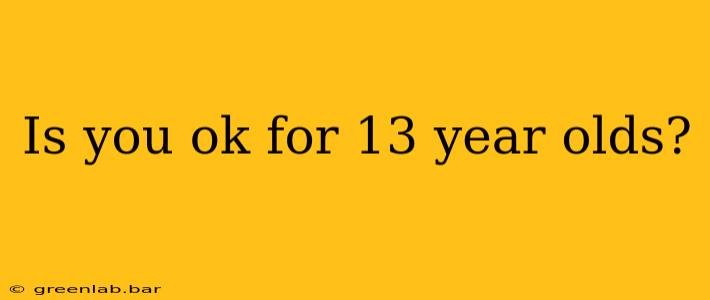Is YouTube OK for 13-Year-Olds? A Parent's Guide to Navigating the Platform
YouTube. It's a digital playground, a learning hub, and a global community all rolled into one. For 13-year-olds, it's a significant part of their social lives, a source of entertainment, and a potential tool for learning and exploration. But is it safe? The short answer is: it depends. This guide will help parents navigate the complexities of YouTube and determine how to best support their 13-year-old's use of the platform.
Understanding YouTube's Age Restrictions and Parental Controls
YouTube's official policy requires users to be 13 years or older to create an account. This is in accordance with the Children's Online Privacy Protection Act (COPPA) in the United States and similar laws in other countries. However, simply having an age restriction doesn't guarantee safety. Pre-teens and teens can still encounter inappropriate content despite these rules.
Fortunately, YouTube offers several parental control features that can help:
- Restricted Mode: This setting filters out content that YouTube deems inappropriate, including videos containing mature themes, violence, or sexually suggestive content. While not foolproof, it's a good first step. Remember that Restricted Mode isn't perfect and some inappropriate content might still slip through.
- Supervised Accounts (Google Family Link): For children under 13 (or younger teens whose parents want stricter control), Google Family Link allows parents to manage their child's YouTube activity, setting screen time limits, reviewing watched videos, and approving or blocking apps and channels.
- Channel Blocking: Parents can block specific channels or creators they deem inappropriate for their child.
The Potential Benefits of YouTube for 13-Year-Olds
Despite the potential risks, YouTube can offer significant benefits for teenagers:
- Educational Content: YouTube boasts a vast library of educational videos covering a wide range of subjects, from science and history to coding and music. Channels like Khan Academy, Crash Course, and TED-Ed offer high-quality learning resources.
- Creative Expression: Many teenagers use YouTube to share their own creative work, whether it's music, art, vlogs, or gaming content. This can be a powerful way for them to develop their skills and express themselves.
- Community Building: YouTube fosters online communities around shared interests, allowing teens to connect with like-minded individuals and build relationships. However, it's crucial to emphasize safe online interactions and the importance of responsible online behavior.
The Potential Risks and How to Mitigate Them
The downsides of YouTube for 13-year-olds are also significant:
- Inappropriate Content: Despite Restricted Mode, harmful content can still be found. This includes violent or graphic videos, sexually suggestive material, and hate speech.
- Cyberbullying: Online harassment and bullying are serious concerns on any online platform, including YouTube.
- Privacy Concerns: Sharing personal information online can have serious consequences. Parents need to educate their children about online safety and privacy best practices.
- Addiction and Excessive Screen Time: YouTube's addictive nature can lead to excessive screen time, impacting sleep, schoolwork, and overall well-being.
To mitigate these risks:
- Open Communication: Talk to your 13-year-old about the potential dangers of YouTube and encourage them to come to you with any concerns.
- Active Monitoring: While respecting their privacy, regularly check their YouTube activity (using Google Family Link if appropriate).
- Media Literacy: Teach them to critically evaluate the information they encounter online, identify bias, and distinguish between credible and unreliable sources.
- Establish Clear Rules and Boundaries: Set limits on screen time and discuss appropriate online behavior.
Conclusion: A Balanced Approach
YouTube can be a valuable tool for 13-year-olds, offering educational opportunities, creative outlets, and social connections. However, it's crucial for parents to be proactive, informed, and involved in their child's YouTube experience. By utilizing parental controls, engaging in open communication, and teaching media literacy, parents can help their teenagers navigate the platform safely and responsibly. Remember, it's about finding a balanced approach that allows for exploration while prioritizing their safety and well-being.

